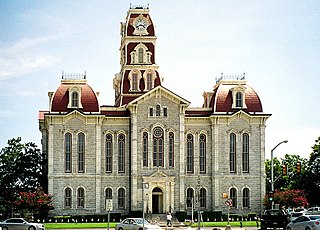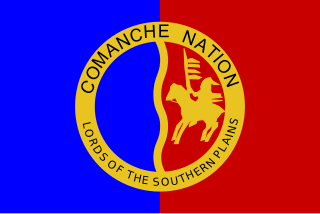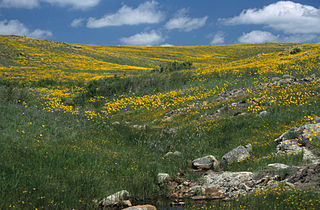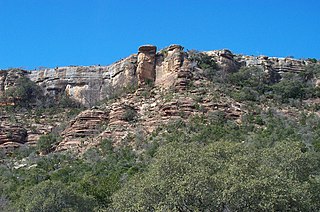| Tackett Mountain | |
|---|---|
| Highest point | |
| Elevation | 1,375 ft (419 m) |
| Prominence | 180 ft (55 m) [1] |
| Parent peak | Miller Benchmark |
| Coordinates | 33°00′10″N98°46′50″W / 33.00278°N 98.78056°W Coordinates: 33°00′10″N98°46′50″W / 33.00278°N 98.78056°W [2] |
| Geography | |
| Location | Young County, Texas, U.S. |
| Topo map | USGS Tackett Mountain |
| Geology | |
| Mountain type | limestone |
| Climbing | |
| First ascent | 1850s |
Tackitt (Tackett) Mountain is a summit in Young County, Texas, USA. It is located west of the Graham, Texas. Site of famous Indian battle between Pleasant Tackitt and Old Piny Chummy.

Young County is a county located in the U.S. state of Texas. As of the 2010 census, its population was 18,550. Its county seat is Graham. The county was created in 1856 and organized in 1874. It is named for William Cocke Young, an early Texas settler and soldier.

Graham is a city in north central Texas. It is the county seat of Young County, and as of the 2010 Census had a population of 8,903.

Pleasant Tackitt was a 19th-century politician, pioneer Methodist minister, stockman, teacher, farmer, Indian fighter and Confederate Officer. Tackitt was a key figure in the history of Arkansas and north Texas, including a state representative of the Arkansas General Assembly. Because of his battles with Indians in Texas, Tackitt became known as "The Fighting Parson".
In the Descriptive History of Early Times in Western Texas, Volume 2, by Joseph Carroll McConnell mentions Tackitt Mountain in the book about the area:

West Texas is a loosely defined part of the U.S. state of Texas, generally encompassing the arid and semiarid lands west of a line drawn between the cities of Wichita Falls, Abilene, and Del Rio.
"Pleasant Tackitt, a Methodist minister, settled in Parker County in
Parker County is a county located in the U.S. state of Texas. As of the 2010 census, its population was 116,927. The county seat is Weatherford. The county was created in 1855 and organized the following year. It is named for Isaac Parker, a state legislator who introduced the bill that established the county in 1855.
1854. Two years later he moved his family to Young County, and numbered among the first settlers of that section. The Tackitt home was located on the old Fort Belknap and Austin Road, about nine miles south of the post, near Fish Creek: so named for the Tackitts broke the ice and caught fish during the severe winter weather.....in the evening of February 13, 1860, one of Mr. Tackitt's milk cows came home through the sleet and snow with an arrow sticking in her side......[Tackitt] back-tracked the cows about three-fourths of a mile, to where they found moccasin racks and saw blankets hanging on the east end of Tackitt Mountain. Tackitt thought it unwise to make an open attack, but decided to advance upon the Indian's from the north......Almost instantly several Indians charged like wild demons. These Indians were under the leadership of Old Piny Chummy, who only a few months before lived on the Comanche Reservation, near old Camp Cooper. Tackitt and his sons knew him well, and no doubt, Piny Chummy recognized the Tackitts......Old Piny Chummy charged Parson Tackitt himself, and the old chief received a mortal wound from the discharge of the parson's gun......A white flag was found flying from the top of a tree on Tackitt Mountain; and under it were found four bridles, four ropes, four bows, and four quivers of arrows, as well as blankets and other implements. A few days later, soaring vultures disclosed the graves of four warriors killed in this fight.
The Comanche are a Native American nation from the Great Plains whose historic territory consisted of most of present-day northwestern Texas and adjacent areas in eastern New Mexico, southeastern Colorado, southwestern Kansas, western Oklahoma, and northern Chihuahua. The Comanche people are federally recognized as the Comanche Nation, headquartered in Lawton, Oklahoma.
'"


















